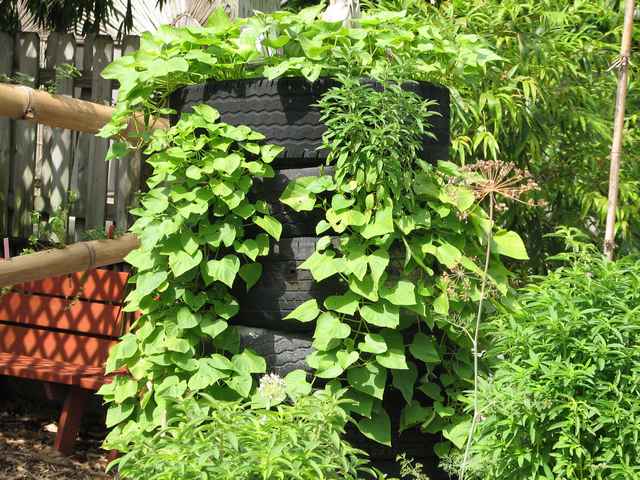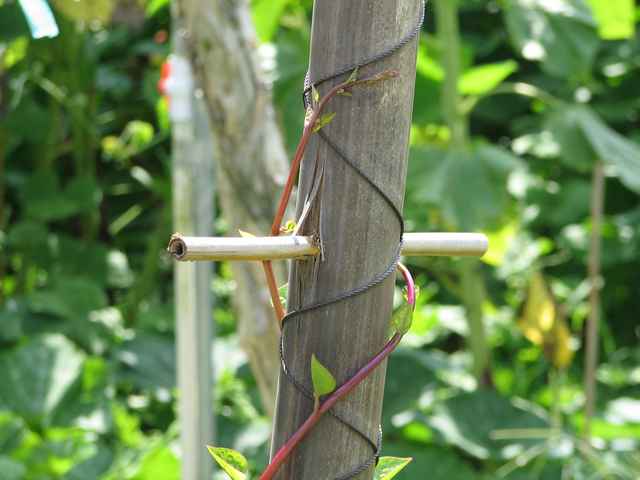I’m titling this one “Part 1”, not because I have a “Part 2” in mind, but because learning new things is an on-going process. I’ll write “Part 2” (and 3, and 4, and …) as soon as I have more lessons learned that I want to record.
More Plant Spacing – I have been planting too closely for most plants. By the time the plants mature, they are so densely packed together that the inner leaves do not get sufficient light, so they just yellow and die. There is not enough air circulation to dry the inner parts of the plants, and though I can’t prove it, I suspect that the plants would be healthier with more room to “breathe”.
Use Plant Cages – Primarily for tomatoes, but also for plants like peppers, some way to stabilize and contain the plants is a major advantage. Some of the tomato plants have grown over the sides of the garden and down to the ground. When they grow that big, they are much more difficult to work with, and much more susceptible to broken branches and other damage. We haven’t had any high winds yet, but plant cages will keep the plants from being blown over by the wind.
Prune Where Needed – The tomatoes ended up putting too much energy into growing branches and leaves rather than in growing fruit. Although pruning tomatoes is more commonly done in the northern parts of the country, I will be pruning my next crop of tomatoes. This is also related to using tomato cages to contain and train the plants.
Upon doing some more reading, it looks like this year’s poor blackberry crop may be due (in part) to not having done any pruning on them. I’ll do that next season. I also neglected to give them the fertilizer and water that they should have gotten.
Grow Up – Not Out – I had planned to use bush beans and determinate variety tomatoes and plant in stages, thinking that I would then get enough beans in a single flush to be able to can the surplus. Somehow, that just didn’t work out as planned. I’ll be going back to pole beans and indeterminate tomato varieties so the harvest is spread out over the life of the plant rather than one large flush of produce and then the plant dies. This also allows for better utilization of the available area in the garden. The various trellis designs that I have been experimenting with look very promising.
Better Planning – I have been pretty much planting wherever there was an empty space in the garden. That kind of haphazard planting just doesn’t work very well in the long term. I will be dividing the garden into 4 sections, and making sure that crops are rotated so that it will be 4 years before a section contains the same type of plant. That should help reduce soil-borne disease and balance out the nutrients in the soil.
Earlier starting – I did fairly well this year, but I still want to start my seeds for the Spring garden around the end of December or first of January. In this part of the country, with the seedling setup that I have, that should work out just fine. There may be some risk of a late frost, but the plants can be covered if needed. I usually try to have at least twice as many seedlings as I plan to use in case of a problem like that. If they aren’t needed, there are plenty of folks eager to take them.
Color Makes a Difference – This year, we planted both yellow squash and zucchini. Both grow about the same, both taste about the same, but both look very different. I discovered that the dark green zucchini is very easy to overlook among the dark green plant. Several times, I have discovered huge zucchinis that are far bigger than I wanted (although they do quite well when baked). They got that way because I overlooked them. Next year, we might be growing yellow squash and not zucchini, we’ll think that over carefully before planting. The bright yellow squash stands out and is a lot easier to see when it’s time to pick them.
Mix it up – I have noticed some differences in the sections of the garden that I can only attribute to not having mixed the growing mixture up well enough. When the hot weather garden is finished, I will be adding some more compost and doing a better job of mixing it up. Just to make sure though, I’ll be doing some soil testing.



































Recent Comments